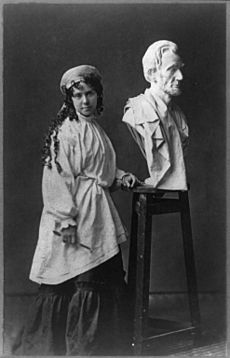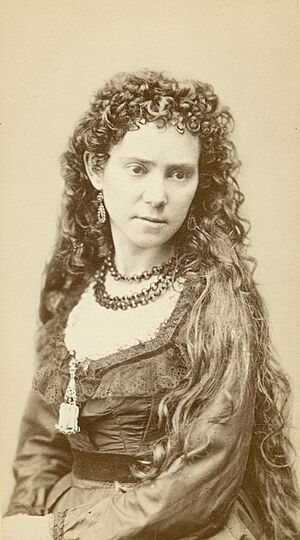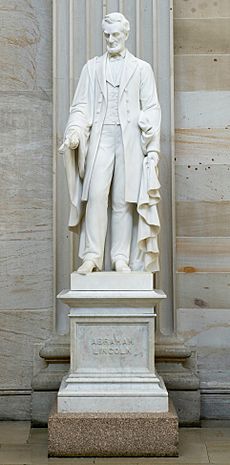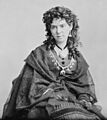Vinnie Ream facts for kids
Quick facts for kids
Vinnie Ream
|
|
|---|---|
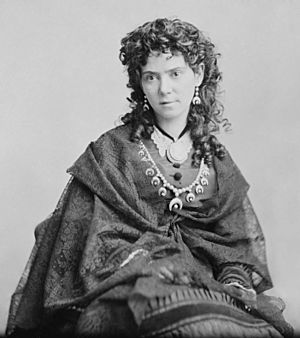 |
|
| Born |
Lavinia Ellen Ream
September 25, 1847 Madison, Territory of Wisconsin, U.S.
|
| Died | November 20, 1914 (aged 67) Washington, D.C., U.S.
|
| Nationality | American |
| Known for | Sculpture |
| Spouse(s) |
Richard L. Hoxie
(m. 1878) |
Lavinia Ellen "Vinnie" Ream Hoxie (September 25, 1847 – November 20, 1914) was a talented American sculptor. She is best known for her statue of U.S. President Abraham Lincoln. This famous statue is located in the United States Capitol rotunda in Washington, D.C.
Vinnie Ream also created other important sculptures. These include the Statue of Sequoyah and the Statue of Samuel J. Kirkwood. Both of these are part of the National Statuary Hall collection. Her Statue of David Farragut is also in Washington, D.C. Some of her works were shown at the 1893 World's Columbian Exposition in Chicago.
Vinnie Ream faced challenges during her career. After President Andrew Johnson's impeachment trial, some politicians blamed her. They accused her of influencing a senator's vote. This was because the senator lived in her home.
Contents
Early Life and Education
Lavinia Ellen Ream was born on September 25, 1847. Her hometown was Madison, Wisconsin. Her father, Robert, worked as a surveyor. He also served the government in the Wisconsin Territory. Her mother had Scottish family roots.
Vinnie attended Christian College in Columbia, Missouri. Today, this school is known as Columbia College. A portrait of Martha Washington painted by Vinnie Ream can still be seen there.
Starting Her Career
In 1861, Vinnie's family moved to Washington, D.C.. Her father's health became poor. Vinnie started working to help support her family. She was one of the first women to work for the U.S. government. From 1862 to 1866, she was a clerk. She worked in the "dead letter office" of the Post Office. This was during the American Civil War.
Vinnie also sang at church and for wounded soldiers. She helped collect supplies for the United States Sanitary Commission.
Becoming a Sculptor
In 1863, Vinnie met the sculptor Clark Mills. A friend, James S. Rollins, introduced them. The next year, when she was 17, she became Mills's apprentice. She learned sculpting in his studio.
In 1864, President Abraham Lincoln agreed to pose for her. He sat for her for five months in the mornings. During this time, she created a bust, which is a sculpture of his head and shoulders. Vinnie also started promoting her work. She sold photos of herself and got attention from newspapers.
Lincoln Statue Commission
Vinnie Ream was the youngest artist and the first woman to get a major art job from the U.S. government. On July 28, 1866, Congress voted for her to sculpt a full-size statue of Lincoln. She was only 18 years old.
She used her earlier bust of Lincoln to win this important job. Some people worried she was too young and didn't have enough experience. There were also rumors that she was a "lobbyist." This meant some thought she used her charm to get what she wanted. She was known for her beauty and good conversation skills. She worked in a studio in the basement of the Capitol building.
Political Challenges
Senator Edmund G. Ross lived with Vinnie's family. This was during the impeachment trial of President Andrew Johnson. Senator Ross cast a key vote that helped President Johnson stay in office. Vinnie was then accused of influencing his vote.
She almost lost her studio in the Capitol. Some politicians tried to turn her studio into a guardroom. This would have forced her to move her unfinished Lincoln statue. Many newspapers were angry about this. They called it unfair to Vinnie. However, a few newspapers supported the move.
Vinnie worried that moving the statue would damage it. Luckily, other sculptors and her friend, Congressman Thaddeus Stevens, helped her. Stevens had been a prosecutor in the impeachment trial. On July 20, 1868, the House of Representatives allowed her to keep her studio for another year.
Completing the Lincoln Statue
After her plaster model was approved, Vinnie traveled to Europe. She visited Paris, Munich, Florence, and Rome. Her goal was to create the final marble statue. In Paris, she studied with Léon Bonnat. She also made busts of famous people like Franz Liszt.
Her studio in Rome was at 45 Via de San Basile. While there, some rumors spread. They claimed that Italian workers, not Vinnie, were responsible for her successful Lincoln sculpture.
When the statue was finished, Vinnie returned to Washington. On January 25, 1871, her white marble statue of President Abraham Lincoln was revealed. It was placed in the United States Capitol rotunda. Vinnie was only 23 years old at the time.
She later opened a studio in New York City. In 1871, she showed her work at the American Institute Fair.
Later Works and Marriage
Vinnie returned to Washington and opened another studio. In 1875, George Armstrong Custer posed for a bust she created. She also showed her art at the Centennial Exposition in 1876.
After talking with William Tecumseh Sherman and Mrs. Farragut, she won a competition. This allowed her to sculpt Admiral David G. Farragut. Her sculpture is located in Farragut Square in Washington, D.C. It was dedicated on April 25, 1881.
Vinnie Ream married Richard L. Hoxie on May 28, 1878. He was an officer in the U.S. Army Corps of Engineers. They had one son. Her husband's job meant they moved often. Richard believed it was not proper for a wife to earn money. So, Vinnie mostly stopped her sculpting work during her marriage.
Later, the Hoxies lived in Washington, D.C. They also had a summer home in Iowa City, Iowa.
Final Works and Legacy
Vinnie Ream's marble sculptures, America, The West, and Miriam, were shown. They were displayed in the Woman's Building at the 1893 World's Columbian Exposition in Chicago.
Vinnie also designed the Statue of Sequoyah. This was the first statue of a Native American in Statuary Hall of the U.S. Capitol.
She passed away in Washington on November 20, 1914. Vinnie Ream and her husband are buried in Arlington National Cemetery. Her statue Sappho marks their grave.
A special postage stamp was made to honor Vinnie Ream. It celebrated her and her work on the Sequoyah statue. The artist George Caleb Bingham painted her portrait twice. The town of Vinita, Oklahoma, was named after Vinnie Ream.
Images for kids
See also
 In Spanish: Vinnie Ream para niños
In Spanish: Vinnie Ream para niños


